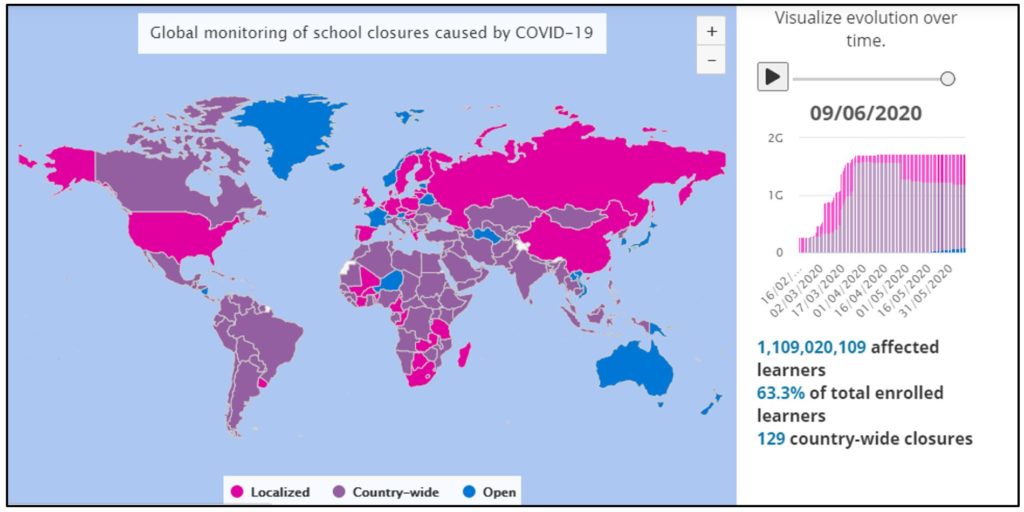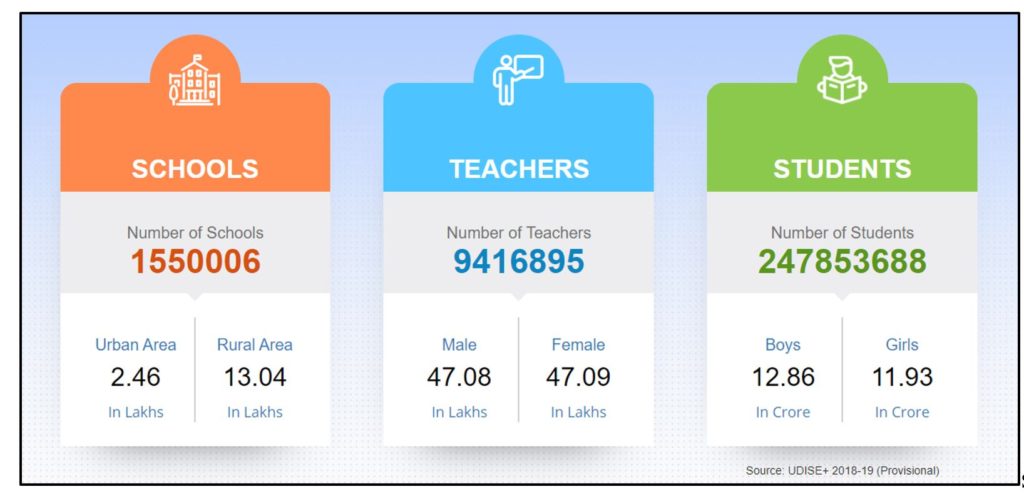Education is probably the worst affected sector by COVID-19. There is an ongoing debate over when to reopen schools & colleges. While the health & safety of children are often discussed and rightly so, the economic & social factors also need to be considered.
There is an ongoing debate on whether schools need to re-open and when amidst the COVID-19 pandemic. Schools and other educational institutions in India were among the first few institutions to be shut. Since March 2020, schools, colleges, coaching centers and all other educational institutions have been shut. Parents and child rights activists are opposing government’s plans to re-open schools and are demanding that school be reopened only when the number of cases go down to zero or vaccines are out. An online petition on change.org titled, ‘No Schools until Zero Covid Case in the State or until Vaccines are out’ has received more than 7.5 lakh signatures as on 10 June 2020. Parents are pushing for continuing this academic year through online classes.
90% of global student population across 190 countries was affected by closure of educational institutions
About 157 crore students, almost 90% of the global student population, across 190 countries have been affected due to the sudden closure of educational institutions to contain the spread of the virus, according to UNESCO. Furthermore, UNESCO added that 100 countries had not yet announced a date for re-opening schools, while 65 countries had plans for partial or full re-opening. A total of 32 countries had decided to end the ongoing academic year online. As on 10 June 2020, country wide closure of schools continues in 144 countries.

In India, the closure did not disrupt the ongoing academic year to a large extent since the lockdown was announced towards the end of the academic year. Many states have already announced cancellation of final exams for the ongoing academic year. Many schools have begun the new academic year via online classes. However, dilemma persists on re-opening of schools because of two main reasons discussed below.
Will re-opening of schools result in rapid spread of COVID-19?
The first of these is whether re-opening of schools will result in rapid spread of the COVID-19. Safety at schools is a major concern for parents since ensuring social distancing and hygiene practices with students is a difficult task. Studies from across the globe show that children may transmit the virus, but not at the level that is being feared.
- The National Centre for Immunisation Research and Surveillance, Australia conducted a detailed investigation of COVID-19 cases in fifteen primary and high schools in New South Wales. The study concluded that SARS- CoV-2 transmission in schools was less likely than that for other respiratory illnesses such as influenza. The rate of disease among children was less. Spread among children and spread from children to adults was also limited.
- According to a study by National Institute for Public Health and the Environment in Netherlands, data from across the world and Netherlands showed that percentage of children among COVID-19 patients was low, ranging from 1% to 6% in younger and older children. The spread was more common among adults and children were infected through family members. Spread of virus among children and children to adults was less common.
- Another study which analyses data from Wuhan (where the first COVID-19 case was reported) and Shanghai showed that children in the age group 0 to 14 years were less susceptible to the infection. But, contact among school age children was the highest, three times that of adults. However, school closure alone would not end transmission but can reduce the incidence by 40 – 60%, delaying the epidemic.
- A German study that analysed the viral load of SARS-CoV-2 by patient age revealed that viral load did not differ much in patients from different age categories, implying children may be as infectious as adults. Symptoms in children are either mild or absent (asymptomatic), and thus diagnosis of the virus is less among children. The study suggested that unlimited re-opening of schools and kindergarten should be avoided.
As can be seen, the studies across the world have thrown up varied results though the common understanding is that children are less susceptible to COVID-19.
Are online classes effective?
Secondly, even though classes have resumed through online platforms, there are questions around the effectiveness of these classes. Meanwhile, access to internet, electricity, and computers or televisions is another important aspect that needs to be addressed if online classes are to continue. Otherwise, those without access to these resources stand to lose out who are mostly the poor & marginalized.
In India, government schools not only provide a platform for learning, but also provide nutrition through midday meals, health, and social protection to students. This part of the schooling system cannot be replaced with online learning and hence students are losing out on these. The MHRD’s dashboard on school infrastructure shows that 96.25% of the schools have electricity and less than 90% have the basic drinking water facility. Since schools lack these basic amenities, availability of laptops/computers, internet, and other facilities for teachers to take online classes is a huge challenge, though some state governments have launched dedicated TV channels to bridge this gap.
Schools play an important role in the labour market
While health & qualitative aspects are no doubt important, the economic aspect of schools is a not often discussed, since it is considered recession-proof. Schools play a pivotal role in the labour market in India, especially the female labour force. Schools provide employment not only to teachers but also maids, security staff, lab assistants, and many others. With the indefinite closure of schools, many of these working in the private sector budget schools stand to lose out on jobs & salaries.
UDISE’s provisional data for 2018-19 shows that there are a total of 15.5 Lakh schools in India, 2.46 lakh in urban and 13.04 lakh in rural areas. Almost 70% of the schools are managed by the government, 21% by private management, 5.4% are aided schools, and the remaining 3.6% fall in the others category.

These schools provide employment to over 94 lakh teachers in the country, number of female teachers being slightly more than their male counterparts. Government provides employment to almost 52.5% of the teachers while private managements employs 35%. Aided schools employ about 8.7% and other schools give employment to 3.8%. In addition to teachers, schools provide employment to many others. Amidst the lockdown, private school employees have had salary cuts and delayed payments. In other words, employment of more than 30 lakh people are affected by closure of schools. If private colleges, coaching centers and other educational institutions are considered, the number of employees affected could be well over a crore, in turn affecting a crore households. The decision to re-open schools should also consider the fate of all these people.
Countries have started gradually re-opening schools
According to UNESCO, in China, schools are re-opening gradually in select regions, especially for those students in the final year of secondary education. Most schools continue to remain closed in larger regions. Schools have been opened in Australia, New Zealand, Netherlands, France, Japan, and Switzerland. In Italy, the government has announced closure of schools till the end of the academic year with classes continuing through distance learning. Meanwhile, in UK, schools are opening in a phased manner- primary schools were scheduled to open from 01 June 2020, and the same for secondary schools was from 15 June. However, only 25% of the secondary school students are to be present at a time. Online education is being promoted.
WHO has released guidance on factors to be considered for re-opening schools
WHO has advised countries to make decisions on whether to close, partially open, or fully re-open schools based on a ‘risk- based’ approach. The following points need to be considered to make decision:
- Current understanding about COVID-19 transmission and severity in children
- Local situation where the school(s) are located
- School setting and ability to maintain prevention and control measures
Further, governments should look at other factors on why schools must open. This includes widening education disparity, risk of non-return to school, domestic violence, etc. If schools are re-opened, it is necessary that social distancing is followed within and outside classrooms for all school activities and immunisation checks is available at entry.
MHRD to decide school re-opening in India in July after consultation with states and UTs
In India, based on Home Ministry’s guidelines issued on 30 May 2020, schools, colleges, and other educational institutions will be opened only after consultations with the states and UTs. The states may hold consultations with parents and other stakeholders at institutional levels. The final decision on re-opening of educational institutions will be taken in the month of July. In the meantime, the HRD minister announced that the ministry was contemplating the option of reducing syllabus and instructional hours in the new academic year. MHRD has also called for suggestions regarding framing of guidelines in education sector.

Featured Image: Reopening of Educational Institutions


